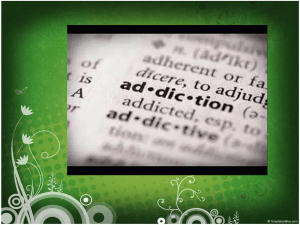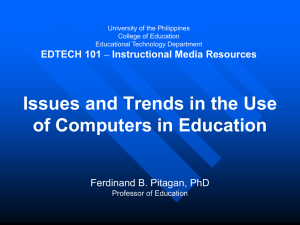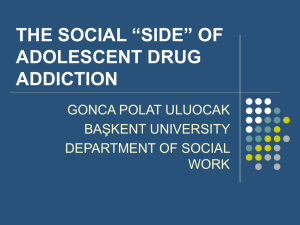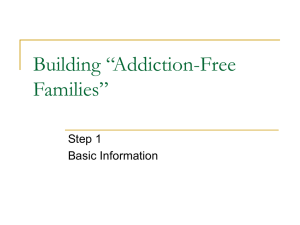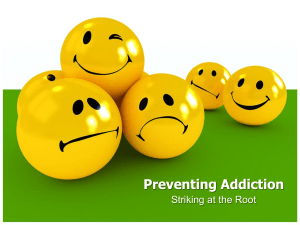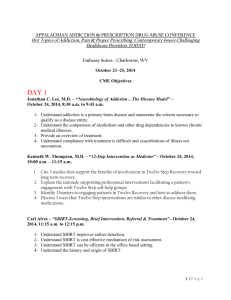WELCOME TO THE TOXIC FAMILY & ADDICTION TRAINING - MI-PTE
advertisement
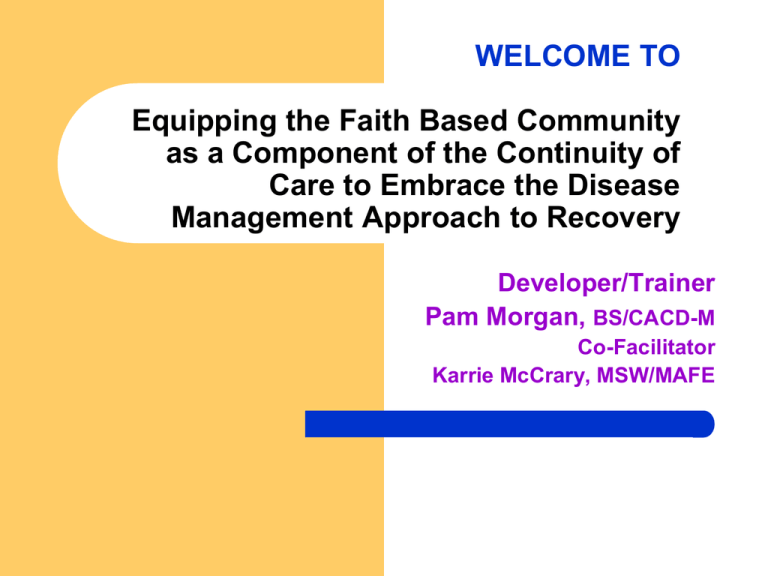
WELCOME TO Equipping the Faith Based Community as a Component of the Continuity of Care to Embrace the Disease Management Approach to Recovery Developer/Trainer Pam Morgan, BS/CACD-M Co-Facilitator Karrie McCrary, MSW/MAFE OBJECTIVES To introduce the faith based community to a comparative look at addiction as a disease as well as addiction from a biblical perspective To enhance the participant’s ability to understand and address the often puzzling dilemma of addiction in the church. To enlighten participants of the various drugs being used in the church and the community at large; the startling statistics, the effects and the addictive nature. Objectives (cont.) To assist the participants in understanding the addict and realizing their role in the addict’s life. To familiarize the participants with addictive behavior and the process of recovering from a lifestyle of addiction, the necessary shift in the role of love ones as the addict recovers and the need for community support and an atmosphere conducive to remaining drug free. MODULE I Introduction Goal: To provide the participant with understanding of addiction from a Clinical and a Biblical perspective, distinguishing between myths, faulty beliefs and truths about addiction. Defining Addiction Addiction in the church today Addiction as a Disease Myths or Truth? Defining Addiction A diseased or sick relationship with a mood or mind altering substance or behavior rendering one powerless to make healthy choices and produces harmful consequences An obsession, compulsion, or excessive psychological dependence, to such things as: drugs, alcohol, video games, crime, money, work, overeating and other eating disorders, gambling, computers, nicotine, pornography, etc. Biblically Defining Addiction Addiction: PERVERTED Worship ...For a man is a slave to whatever controls him. II Peter 2:19 Perverted Worship: – Excessive devotion to the extent of jeopardizing family, job, finances and economic security, relationships, etc. – When a person seeks relief from painful realities by altering their mood and experiencing instant gratification, they become addicted to whatever route they find to temporarily relieve them. They in turn become devoted to this source of relief and give up everything for that feeling to reoccur, worshipping the source of their relief. Can Church be Addictive for the Recovering Addict? Euphoric High in Religion Church on Sunday/Drugs on Monday Blind leading the Blind Biblical History of Addiction Old Testament New Testament The Role of today’s Church concerning Addiction • • Coming out of Denial Acknowledging the presence of addiction Addiction as a Disease CLINICALLY SPEAKING 1956 Formal recognition by AMA Describable, Predictable, Progressive, Primary, Permanent, Terminal if left untreated 3 MAJOR ASPECTS PHYSICAL – COMPULSION Limbic Reward System / Dopamine release Hardwiring of the Brain MENTAL – Obsession SPIRITUAL – Dependence MODULE II Startling Realities To enlighten participants of the various drugs and other addictions being used in the church and the community at large; the startling statistics, the side effects and the addictive nature. Statistics Effects: Physical, Mental and Spiritual Prescription drugs abuse – An uprising trend – Street drugs; opiates, inhalants, methamphetamines, hallucinogens, club drugs Drug Abuse and the Church: Are the Blind leading the Blind? 1. 2. 3. 1 in 8 adults in America suffering from chemical dependency 17 million alcoholics; 25% teens 47% of all Americans are effected by substance abuse; especially alcohol Various Drugs / Statistics Youth National Institute on Drug Abuse's (NIDA) – – 9.3 percent of 12th-graders reported using Vicodin without a prescription in the past year 5.0 percent (of 8th – 12th graders) reported using OxyContinmaking these medications among the most commonly abused prescription drugs by adolescents. The abuse of certain prescription drugs-opioids, central nervous system (CNS) depressants, and stimulants- can alter the brain's activity and lead to addiction. Various drugs / Statistics The Drug Abuse Warning Network (DAWN), monitors medications and illicit drugs reported in emergency departments (EDs) across the Nation Two of the most frequently reported prescription medications in drug abuse-related cases are – – – benzodiazepines (e.g., diazepam, alprazolam, clonazepam, and lorazepam) 100,784 drug abuse cases in 2002 opioid pain relievers (e.g., oxycodone, hydrocodone, morphine, methadone, and combinations that include these drugs). 119,000 Taken due to Drug addiction and desired psychoactive effects Older Adults Persons 65 years of age and above comprise only 13 percent of the population, yet account for approximately one-third of all medications prescribed in the U.S More likely to be prescribed long-term and multiple prescriptions, which could lead to unintentional misuse. The elderly also are at risk for prescription drug abuse, in which they intentionally take medications that are not medically necessary. OTC medicines and dietary supplements. MODULE III Addressing Issues / Viable Solutions Strongholds Recovery vs. Deliverance Maintaining Recovery or Deliverance Q&A STRONGHOLDS The garbage rats are attracted to, where they feed and hide. A stronghold is a spiritual fortress (wall) of thought created by various acts inflicted upon a person over the years where strong influences may enter in , hide and be protected. Rejection, Embarrassment, Falsely Accused, Abandonment, Betrayal, Insulted, Abused (physically, mentally, spiritual, sexually, verbal) Disappointed Recovery vs. Deliverance: What’s the difference? Why Some Deliverance (Process) vs. Instantaneous total deliverance What’s expected? Facts About Feelings They can come in combinations They don’t just disappear They can lead to relapse Others don’t “make you” feel a certain way Feelings can be sneaky Feelings follow change Maintaining Deliverance / Recovery 7 Steps in Temptation-Triggers & Urges Tempted –thought of evil Drawn away by strong imagination Lust –overwhelmingly strong desire Enticed: weakened will Yielding (when lust is full grown) Sin: actual act committed Results / Consequences An ENEMY To the Recovery Process: SICK PRIDE- HUMILITY VS. PRIDE Pride: arrogance/ conceit; inordinate (unreasonable or unwarranted)self-regard; thinking more highly of oneself than warranted Comes before shame Always goes before a fall Having knowledge of the will of God but disregarding it because you think you know best for your self or you think that in spite of knowing that a thing is wrong, you can beat the odds and make it work out for you. Early Warning Signs 1. H.A.L.T - STRATEGIES FOR HANDLING STRESS GET HONEST, GET HUMBLE, GET HELP 2. Thoughts (unreasonable or unhealthy) 3. Behaviors (which are not conducive to ongoing recovery) Maintaining Deliverance / Recovery Breathing into a brown bag Reading personal journal Calling someone who has substantial years free and has agreed to be a support person for you. Going to Church Support Groups or NA/AA meetings and sharing feelings Maintaining Deliverance / Recovery Experiencing Feelings such as loneliness, shame, resentment, sadness, anxiety, rage, etc. A. THIS TOO SHALL PASS B. NAME THE FEELING C. IDENTIFY THE EVENT OR SITUATION D. LIST PERSONAL BELIEFS OR THOUGHTS ABOUT IT E. RESPOND WITH POSITIVE ACTION (IN SPITE OF FEELINGS)



